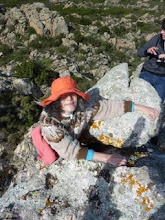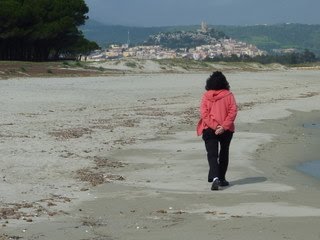Written: April 2, 2010
Yes, it's been nearly a month since we left the US for our Italian honeymoon and we apologize that this is our first real trip report. You probably wondered if we had fallen off the planet. We'll try to do better from now on :-).
For now, a quick update. We arrived at our first destination,
Barga, with no serious glitches, flying into Pisa via London. Our friends there - Tom and Julia Gabbay - graciously lent us a spare apartment they keep in the historic center, which is a completely intact medieval hill town surrounded by mountains - the Apuans (where Carrera marble is quarried) to the west, and the Appeninnes (the central spine of Italy) to the east.. This was a very beautiful start for us and, after a week, we were largely over jet lag and wanted to stay forever. We wandered about the crooked lanes, hung around the cafes, and took long walks into the sparkling countryside.
We also got to spend some time in lovely Lucca, a beautiful and very laid-back renaissance town with a number of noteworthy buildings, including a delightful mini-Duomo, graced below by the delightful Miss Lynnie.
In addition, Lucca's entire town wall is completely intact, with the top now a wonderful circular park beloved of walkers, cyclists and, of course, tourists - it offers delicious glimpses into this precious town from a unique perspective (see below).
After a week, however, we decided to squeeze in a week-long side-trip to Florence, largely because Lynnie had never been there before. After our quiet, bucolic week in Barga, bustling, touristy Florence - even in the off-season - was a bit of a shock. Fortunately, we were able to rent a small but cozy apartment in an old palazzo in a quiet neighborhood at the edge of the pedestrian center, which meant we could easily walk to all the sights and events, but also quickly escape the crowds as needed. We managed to take in the
Uffizi, the
Strozzi - fabulous special exhibits - and the
Accademia. We also attended a couple of interesting concerts, visited some smaller museums, and strolled around a good deal of the historic center.
Finally, we managed to squeeze in a wonderful overnight in nearby
Fiesole, another lovely Tuscan hillltown, staying over one night at the very traditional
Pensione Bencista, which we highly recommend. In addition to being wonderfully comfortable and rigorously traditional, it sports a one-of-a-kind view overlooking downtown Florence (look for the famous Duomo to the far left in the background of the picture below).

Finally, we were ready to fly to Sardinia, our main destination. There we were picked up at the
Alghero airport by Giancarlo, the boyfriend of Cinzia, our hostess, and taken back to our new home outside of
La Caletta, a small fishing port and beach resort on the east coast. The two-bedroom cottage sits in a lovely valley, encircled by mountains and surrounded by small farms, with about a half-acre of its own land. It's just a quick drive - or a long walk - from several long and very beautiful white-sand beaches.
In the summer, this is a tourist mecca. Right now, however, there are almost no tourists and not very many residents either - sometimes it feels like we are on a deserted island all by ourselves! When we do want some human contact, we wander into one of the many sleepy villages and small towns sprinkled around and hang around the 'centro storico' sipping a cafe latte at some vintage cafe - tough life :-).
For food, we've mostly been shopping at local groceries, farm stands, and agriturismos (farms with rooms, restaurants and/or food shops), and then cooking/eating at home. The local cheese, meat, fish, honey and fruit are great. If we do need something more, there's a big mall (by Sardinian standards) in
Olbia, about a 30-minute drive north but, so far, we've only been there once, and we're not rushing back. :-)
At this point, we've only been in Sardinia about 10 days, but we've already seen some very beautiful areas. The island is quite mountainous, with very little flat area, and most of this tucked away in small inland valleys. As a result, there is only one really large population center,
Cagliari, which is about 3 hours away in a larger valley at the southern end of the island, which we haven't visited yet. Otherwise, the island is very rural. Even the biggest towns up here in the north -
Sassari,
Nuoro,
Olbia - have a very laid-back feel, and are surrounded by huge natural areas. Along the northeast coast, there is a touristy feel to many of the towns and beach areas, but, once you go even a few minutes inland, this largely disappears. And, even along the coast, there are large areas with almost no development, and with corresponding long, empty beaches that don't fill up even in the summer.
Despite their reputation among mainland Italians for being standoffish, the Sardinians we have met have been very friendly. They have a very distinct culture and attitude compared to Italian mainlanders, and even speak their own language called 'Sardo', which is more a dialect of Latin, and not directly related to Italian. Our best guess is that their reputation as standoffish is due to their very understandable reaction to the hordes of rowdy Italian tourists who descend on the beach areas in July and August.
As tourists, we are lucky to be in staying in a real Sardinian house, and have contact with real Sardinians through Cinzia and her boyfriend Carlo (see his photo with Michael below). For example, Cinzia's brother,
Elio, is a well-known artist in nearby Nuoro, with a particular interest in documenting local folk cultures, so he has contacts all over the island. Also, our nearest neighbor across the street, Giovanni, is the former area police chief, and of course knows everyone in the area.
In general, everyone we meet here - natives and tourists - are usually surprised to find out that we are Americans, as hardly any Americans ever visit here, even during the tourist season. The overwhelming number of tourists are Italian, with a smattering of French, German, and Spanish visitors. The majority of the off-season tourists we have run into so far are German, who apparently come down to enjoy an early spring. We also have met a number of mainland Italians who have moved here year-round to enjoy the relaxed, rural lifestyle.
So far the weather has been wonderful. We had a few rainy, foggy days when we arrived, but now it is sunny everyday, but still cool enough (low-to-mid 60Fs) to allow us to hike around in mid-day without getting overheated. Spring has definitely sprung, and there are wildflowers and blossoms everywhere. The air is heavenly - full of flowery scents and completely clean, even in the towns. That is partly because the island tends to be a bit windy this time of year.
Anyway, that's probably more information than you want in one sitting, so we'll save the rest for later....
Ciao for now...



































